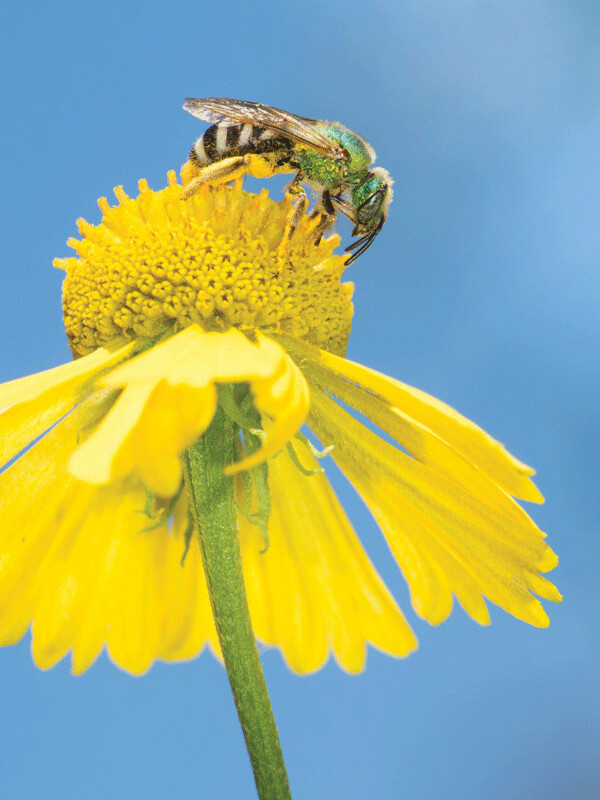All a-buzz

While white snow swirls outside my window, a cloud of yellow floats inside my head. My brain is buzzing with facts about pollen and bees, as all of my coworkers and a merry band of volunteers put the final touches on our new exhibit: Bee Amazed!
The original vision for an exhibit on bees came from one of our dedicated volunteers. She imagined a room draped in golden, honey-colored cloth, with hexagons everywhere, and an observation hive of honey bees busily buzzing away in a corner. Like most of us, she was focused on the highly visible, newsworthy, honey bee. But honey bees aren’t native to North America. Because of the value of their honey and wax, they were brought here very early in the process of European colonization. Some escaped and started living in the wild, but most of them remain under the care of humans in our backyards, small farms, and in our system of industrialized agriculture.
I knew that the exhibit would need to focus a little bit more on our native bees, in order to fulfill the Museum’s mission of connecting people to Northwoods nature, so I contacted Heather Holm. Heather’s first book, Pollinators of Native Plants, is one we’ve used as a resource during the planting of our rain gardens and pollinator gardens here at the Museum. Her second, award-winning book, Bee: An Identification and Native Plant Forage Guide, is a wealth of information, and has been very useful in organizing information for our exhibit.
Heather agreed to be an expert consultant on our exhibit, and a grant from the Four Cedars Environmental Fund of the Duluth Superior Area Community Foundation made it possible.
My first conversation with Heather turned our exhibit on its head. Honey bees, she told us, can actually compete with native bees for resources. Honey bee workers travel two miles or more from their hive to gather nectar and pollen, and they visit a wide variety of flowers. Most of our native bees are single, working mothers who will try to forage as close to their nests as possible, which may mean only flying tens of feet away. A typical hive of honey bees can gather the equivalent amount of food that 100,000 solitary bees would need over the course of the summer.
This information was shocking to me and the rest of our exhibit development committee, especially since most of the hype (up until very recently) has been about colony collapse disorder and the plight of honey bees. Honey bees are a necessary component of our industrial, monoculture-based agricultural system, and I do love honey, but native bees are integral to the thriving of our global ecosystems. About 90 percent of flowering plants need animals to pollinate them, and that includes about one-third of our food crops. While hummingbirds, bats, butterflies, moths, and other insects pollinate some flowers, bees are the real champions of pollination.
What makes native bees so effective? It all comes down to pollen. Bees are more focused than any other pollinator on collecting pollen. Pollen is the male reproductive cell of a flower, and in order to fertilize the ovule and produce a viable seed, it needs to land on the stigma of another flower of the same species. Pollen is also a rich source of protein, so native bees have evolved elaborate systems of branched hairs, electrical charges, and special stomachs to help them transport pollen back to their nests. Once there, the female bee mixes the pollen with nectar and saliva to create “bee bread.” This organic baby food will be stored with each new egg to feed the larva once it hatches.
In this symbiotic relationship between bees and flowers—honed over 125 million years—it’s no accident that the pollen-carrying adaptations of native bees are somewhat messy. It is absolutely essential that dusty little poofs of pollen shake off at each new flower. Honey bees are more interested in collecting nectar than pollen, and when they do collect pollen, they mix it with nectar and store it in pollen baskets on their legs. This minimizes pollen lost along the way, but also reduces their usefulness to the plant.
Some of our native bees, including bumble bees, mining bees, sweat bees, and carpenter bees, use an even messier form of pollen collection known as “buzz pollination.” By grasping a flower, detaching their flight muscles from their wings, and buzzing loudly, these bees shake the pollen out of the flower. Some flowers—including human favorites like tomatoes, eggplants, cranberries, and blueberries—need this technique for effective pollination. Honey bees are inefficient, if not ineffective, at pollinating these flowers.
This is only the beginning of what I’ve discovered. Native bees are bigger, smaller, hairier, shinier, and more colorful than I ever imagined. A rainbow of bees is hard at work in the Northwoods. I hope you’ll visit “Bee Amazed!” at the Cable Natural History Museum after it opens on May 1. I know you’ll be just as amazed by the beauty and diversity of our native bees as I am.
Special Note: Emily’s book, Natural Connections: Exploring Northwoods Nature through Science and Your Senses is here! Order your copy at http://cablemuseum.org/natural-connections-book/.
For 50 years, the Cable Natural History Museum has served to connect you to the Northwoods. Come visit us in Cable, WI! Our new exhibit: “Bee Amazed!” opens on May 1, 2018.

